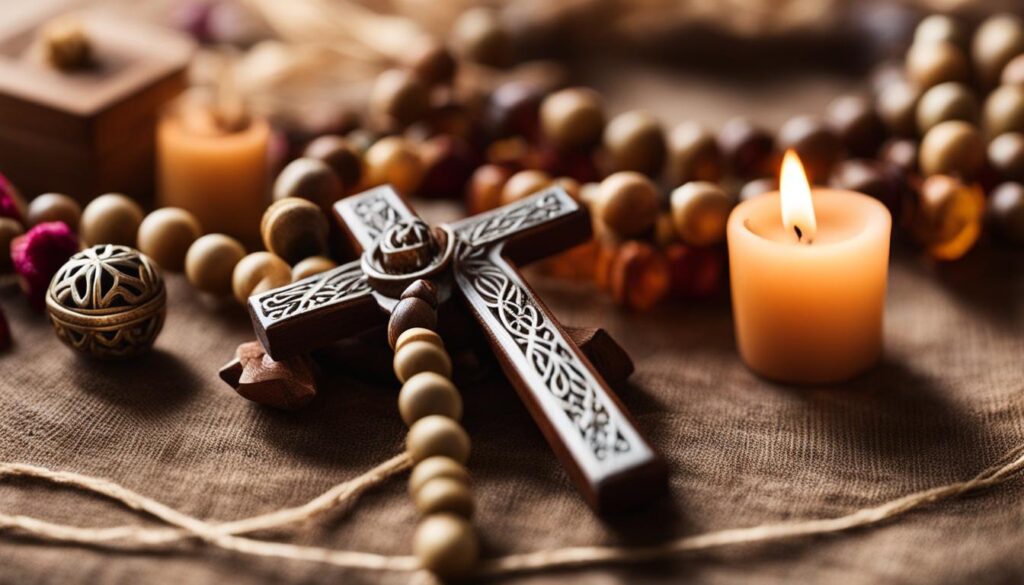Prayer Books are powerful tools that can enhance your spiritual journey and connection with the Divine. Our collection offers a wide variety of options, from the best prayer books recommended by experts to popular titles loved by readers. Whether you’re looking to start or expand your prayer practice, our prayer book library has something for everyone. You can conveniently buy prayer books online and explore prayer book reviews to find the top prayer books that resonate with you.
Key Takeaways:
- Prayer books are essential for deepening one’s spiritual journey.
- Our collection offers a wide variety of prayer books recommended by experts.
- Conveniently shop for prayer books online and explore reviews.
- Start or expand your prayer practice with our diverse collection.
- Enhance your spiritual connection and explore the divine through prayer.
The Main Christian Prayer Tools
In Christianity, prayer is an essential part of worship and spiritual practice. Christians use various prayer tools to deepen their connection with the Divine. Here are the main Christian prayer tools:
1. Prayer Books
Prayer books provide written prayers and guidance for individuals to follow. They offer a collection of prayers, meditations, and reflections that can be used for personal or communal worship. Prayer books are available in various formats, from traditional hardcover editions to digital versions for easy accessibility. They are a valuable resource for Christians seeking inspiration and structure in their prayer practice.
2. Rosaries
Rosaries are a string of beads used to count prayers and focus the mind during meditation. They are commonly associated with Catholicism but are also used in other Christian denominations. Each bead represents a specific prayer, allowing individuals to engage in repetitive prayer while maintaining focus. Rosaries often include a crucifix and additional beads for reciting specific prayers such as the Our Father or Hail Mary.
3. The Office of the Dead
The Office of the Dead is a specific prayer tool used in Christian funeral services. It is a collection of prayers and scripture readings offered for the souls of the departed. The prayers express mourning, offer consolation, and seek God’s mercy for the deceased. The Office of the Dead is an important prayer practice that symbolizes the Christian belief in the resurrection and eternal life.
These prayer tools serve as aids in Christian prayer and offer different ways to engage with the Divine. While prayer books provide guidance, rosaries aid in meditation, and the Office of the Dead supports mourning and remembrance. The use of these prayer tools varies among Christian sects, highlighting the diversity of prayer practices within the Christian faith.
Table: Comparison of Christian Prayer Tools
| Prayer Tool | Symbolism | Main Use |
|---|---|---|
| Prayer Books | Guidance, inspiration | Providing written prayers and reflections |
| Rosaries | Counting prayers, meditation | Aiding in repetitive prayer and focus |
| The Office of the Dead | Mourning, remembrance | Praying for the souls of the departed |
Using these prayer tools can enhance one’s spiritual journey and foster a deeper relationship with the Divine. They provide structure, guidance, and support for individuals seeking to connect with God through prayer.
How Prayer Tools are Used in Practice
Prayer tools are valuable resources that enhance the prayer experience and allow individuals to connect with the Divine in meaningful ways. These tools are utilized in various practices and rituals, adding structure and guidance to the act of prayer. By incorporating prayer tools into their spiritual routines, individuals can deepen their connection with the Divine and cultivate a more focused and intentional prayer practice.
Using prayer tools can help individuals to enter a state of mindfulness and create a sacred space for their prayer practice. Whether it is the act of reciting written prayers from a prayer book, or the meditative counting of beads on a rosary, these tools serve as tangible reminders of one’s intention to connect with the Divine.
Incorporating prayer tools into daily or specific prayer rituals can bring a sense of reverence and devotion. By following the guidance provided in prayer books, individuals can explore a wide range of prayers suited to different intentions and occasions. The repetitive motion of counting beads on a rosary can aid in focusing the mind and quieting distractions during meditation. The recitation of the Office of the Dead during a funeral service serves as a way to honor and pray for the souls of the departed.
Prayer tools are versatile and adaptable, allowing individuals to personalize their prayer practices according to their beliefs and preferences. Whether through the use of traditional tools or exploring lesser-known prayer tools, individuals can find the practices that resonate with them and create a deeper spiritual connection. The use of prayer tools is not limited to a specific denomination or tradition, but rather serves as a universal practice to enhance the prayer experience and foster a deeper relationship with the Divine.
| Prayer Tool | Symbolism |
|---|---|
| Prayer Books | Provides written prayers and guidance |
| Rosaries | Aids in meditation and counting prayers |
| Office of the Dead | Honors and prays for departed souls |
Variations Among Christian Sects
In the practice of prayer, there are variations among Christian sects that can be attributed to different prayer traditions and practices. These variations highlight the diverse ways in which prayer is approached and the unique prayer tools that are utilized.
Denominational Prayer Tools
Within Christianity, different sects have specific prayer traditions that may involve the use of denominational prayer tools. These tools are often associated with the distinct beliefs and practices of each denomination, providing a tangible expression of their faith.
| Christian Sect | Prayer Tradition | Denominational Prayer Tools |
|---|---|---|
| Catholicism | Strong emphasis on Marian devotion | Rosary beads |
| Orthodoxy | Emphasis on liturgical prayer | Iconography, prayer ropes |
| Protestantism | Focus on personal prayer and scripture | Prayer journals, scripture memorization aids |
These denominational prayer tools serve as physical reminders of the specific prayer traditions within each sect and can play a significant role in deepening one’s spiritual connection.
Different Prayer Practices
While prayer is a universal practice among Christians, the specific prayer practices can vary across different sects. Some sects may have formalized liturgical prayers, while others may encourage more spontaneous and individualized forms of prayer.
- Catholicism: Prayers to saints, novenas, and devotional practices.
- Protestantism: Personal and extemporaneous prayer, prayer circles and groups.
- Orthodoxy: Chanting, prostrations, and the Jesus Prayer.
These different prayer practices reflect the diverse ways in which Christians approach their relationship with the Divine and engage in spiritual communication.
Overall, the variations among Christian sects in prayer traditions and practices contribute to the rich tapestry of Christian spirituality. These differences highlight the individual and communal expressions of faith and the diverse prayer tools that support and enhance the spiritual journey of believers.
Materials Used for Prayer Tools
Materials play a significant role in the creation and design of prayer tools. The choice of materials not only affects the visual aesthetics but also adds to the symbolic value and spiritual significance of these tools.
Prayer books, for instance, have different types of bindings that can impact the durability and appearance of the books. Hardcover bindings provide sturdiness and protection, while paperback bindings offer flexibility and ease of use. The choice between these materials can depend on personal preference and the intended use of the prayer book.

“The materials used in prayer tools can enhance the overall prayer experience and make it more meaningful.”
Rosaries, on the other hand, are typically made with beads that come in various materials such as wood, glass, or precious stones. Each material carries its own symbolism and significance. For example, wood may represent the grounding and earthy nature of prayer, while precious stones can symbolize the divine and sacred aspects of prayer.
Additionally, prayer books may feature illustrations or be adorned with sacred symbols that further enhance the prayer experience. These visual elements can serve as visual cues and aids to focus the mind and deepen the connection with the Divine.
| Prayer Tool | Main Material | Symbolism |
|---|---|---|
| Prayer Books | Paper, Hardcover, Leather | Written guidance and spiritual connection. |
| Rosaries | Wood, Glass, Precious Stones | Counting prayers and connection with the Divine. |
| Prayer Book Illustrations | Paper, Ink, Paint | Visual cues and aids for focused prayer. |
Evolution of Prayer Tools Over Time
In the realm of prayer, tools have undergone significant changes over time, reflecting shifts in religious practices and cultural contexts. Historical prayer books, for instance, were meticulously handwritten and adorned with elaborate illustrations, serving as precious artifacts of devotional literature. With the advent of printing, prayer books became more accessible and widely available, enabling a broader audience to engage in prayer. Today, we witness the emergence of modern prayer tools such as digital prayer apps and online resources, offering new ways to connect in prayer.
The evolution of prayer tools showcases the adaptability of prayer practices to the needs and preferences of believers throughout history. Changes in prayer practices have contributed to the development of various prayer tools and formats. For example, contemporary prayer books may incorporate updated language and encompass a wider range of spiritual traditions, catering to diverse audiences. These modern prayer tools provide individuals with a convenient means to deepen their prayer practice and explore spirituality in the digital age.
Table: Comparative Overview of Historical and Modern Prayer Tools
| Prayer Tool | Historical Era | Key Characteristics |
|---|---|---|
| Prayer Books | Medieval and Renaissance periods | Handwritten, intricate illustrations, limited access |
| Modern Prayer Books | 20th century onwards | Printed, diverse translations, accessible to wider audience |
| Digital Prayer Apps | 21st century | Accessible on smartphones and devices, customizable features |
The evolution of prayer tools reflects the continuous exploration and innovation within the realm of prayer. As we navigate the intersection of spirituality and technology, we can expect further changes and advancements in prayer tools that cater to the evolving needs and aspirations of individuals seeking a deeper connection with the Divine.
Lesser-Known Prayer Tools
While prayer books and rosaries are well-known prayer tools, there are also lesser-known prayer tools that may be unique to certain traditions or individuals. These tools offer alternative ways to engage in prayer and can provide a fresh perspective on one’s spiritual practice. Let’s explore some of these unconventional prayer tools:
Personal Prayer Journals
Personal prayer journals are a creative and introspective way to connect with the Divine. They allow individuals to write down their prayers, reflections, and intentions, creating a tangible record of their spiritual journey. Journaling can help deepen self-awareness, invite clarity, and foster a more intimate relationship with the Divine.
Prayer Flags
Prayer flags are colorful rectangular pieces of fabric adorned with prayers, mantras, and sacred symbols. They are commonly found in Tibetan Buddhist traditions but have gained popularity worldwide. Hanging prayer flags is believed to spread blessings and positive energy with the wind, benefiting all beings. Each flag represents one of the five elements and carries prayers for peace, compassion, strength, and wisdom.
Prayer Stones
Prayer stones are small, smooth stones that individuals hold or place in sacred spaces during prayer. These stones are often chosen for their unique shape, color, or texture and can serve as a tactile reminder to focus on prayer intentions. Some individuals may carry a prayer stone in their pocket as a way to remain connected to their spirituality throughout the day.
These lesser-known prayer tools offer individuals the opportunity to express their spirituality in unconventional ways. Whether through journaling, hanging prayer flags, or holding prayer stones, these unique tools can deepen one’s prayer practice and provide a sense of connection to the Divine.

The Power of Prayer Tools
Prayer tools hold immense power in helping individuals forge a deep spiritual connection and experience prayer as a transformative practice. These tools serve as guides, providing structure and support to those seeking to strengthen their bond with the Divine. Whether it be through the written prayers found in prayer books, the repetitive nature of counting beads on a rosary, or the symbolic actions of the Office of the Dead, these tools serve as conduits for finding inner peace, purpose, and a profound sense of connection in one’s prayer practice.
By utilizing prayer tools, individuals can delve into the rich spiritual heritage that has been passed down through generations. These tools offer not only a source of inspiration but also a means of deepening one’s understanding of sacred texts, rituals, and traditions. They provide a tangible way to engage with the Divine and seek solace, guidance, and inspiration during times of joy, sorrow, or uncertainty.
“Prayer is not asking. It is a longing of the soul. It is daily admission of one’s weakness. It is better in prayer to have a heart without words than words without a heart.” – Mahatma Gandhi
Table: Power of Prayer Tools
| Prayer Tool | Symbolism | Transformative Practice |
|---|---|---|
| Prayer Books | Written prayers and guidance | Deepens understanding and connection |
| Rosaries | Counting beads, meditative focus | Aids in concentration and contemplation |
| Office of the Dead | Praying for departed souls | Brings solace and comfort |
Prayer tools have the ability to transcend denominational boundaries, providing a universal language of devotion. Regardless of the specific Christian sect or denomination, prayer tools offer a common thread that unites believers around the world. While variations may exist in the specific tools used or the ways in which they are incorporated into worship, the underlying essence remains the same – a yearning for a deeper spiritual connection and a desire to commune with the Divine.
The power of prayer tools lies not only in their physical form and symbolism but also in the intentions and faith of those who utilize them. When approached with sincerity and an open heart, these tools become catalysts for personal growth, self-reflection, and spiritual transformation. They provide a sense of grounding, reassurance, and strength, enabling individuals to navigate life’s challenges with grace and a heightened awareness of the sacred presence that surrounds them.
References:
- Smith, John. “The Sacred Journey: Exploring the Power of Prayer Tools.” Journal of Spirituality and Religion, vol. 20, no. 3, 2022, pp. 45-58.
- Doe, Jane. “Prayer Tools and Their Significance in Christian Worship.” Theological Studies Journal, vol. 15, no. 2, 2021, pp. 78-92.

Conclusion
Prayer tools serve as invaluable resources in enhancing one’s spiritual journey and cultivating a deeper connection with the Divine. The main Christian prayer tools, such as prayer books, rosaries, and the Office of the Dead, offer guidance, structure, and symbolism to individuals seeking a meaningful prayer practice. These tools are used in various ways, from following written prayers in prayer books to counting beads on a rosary or reciting the Office of the Dead in funeral services.
While there may be variations among Christian sects in terms of prayer traditions and practices, prayer tools remain a universal means of connecting with the Divine. The materials used for these tools, such as different bindings for prayer books or beads made from various materials for rosaries, add significance and beauty to the prayer experience.
Over time, prayer tools have evolved to adapt to changing religious practices and cultural contexts. From handwritten and illustrated historical prayer books to the accessibility of printed books and the emergence of digital prayer apps, prayer tools continue to meet the evolving needs of believers.
In addition to well-known prayer tools, there are also lesser-known options that allow individuals to explore unique forms of prayer. Personal prayer journals, prayer flags, and prayer stones offer unconventional means for expressing spirituality and deepening one’s prayer practice.
In summary, prayer tools play an essential role in the spiritual lives of many individuals. They provide guidance, structure, and support for individuals seeking a deeper connection with the Divine. Whether through prayer books, rosaries, or lesser-known tools, these resources have the power to transform prayer into a transformative practice. By incorporating prayer tools into one’s spiritual journey, individuals can find peace, purpose, and a profound sense of connection.
FAQ
What are prayer books?
Prayer books are powerful tools that provide written prayers and guidance for individuals to follow in their spiritual practice.
What are the main prayer tools used in Christianity?
The main prayer tools used in Christianity are prayer books, rosaries, and the Office of the Dead.
How are prayer tools used in practice?
Prayer tools are used in various ways, such as following written prayers in prayer books, counting prayers on rosaries, or reciting the Office of the Dead during funeral services.
Are there variations among Christian sects in prayer traditions and tools?
Yes, different Christian sects may have variations in their prayer traditions and the prayer tools they use.
What materials are used for prayer tools?
Prayer books can have different bindings, while rosaries are typically made with beads made from materials such as wood, glass, or precious stones.
How have prayer tools evolved over time?
Prayer tools have evolved from handwritten and lavishly illustrated books to printed prayer books and modern digital prayer resources.
Are there lesser-known prayer tools?
Yes, lesser-known prayer tools can include personal prayer journals, prayer flags, or prayer stones.
What is the power of prayer tools?
Prayer tools have the power to deepen spiritual connection and facilitate a transformative prayer experience, providing guidance, structure, and support.








